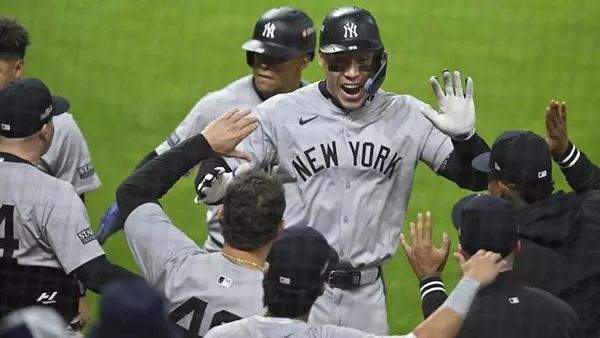RALEIGH, N.C. _ As recently as last week, no one around the Carolina Hurricanes was quite sure if and when Jordan Staal would be back on the ice with the team. Even as Staal skated on his own, the concussion that took over his life was so all-encompassing that there was no way to confidently predict his progress.
Staal spent months swimming in that unknown, waking each morning wondering if that day was the day he would feel normal again, clinging to any kind of forward momentum, trying to rest his brain and test his brain at the same time.
Thursday, wearing a yellow no-contact jersey, Staal practiced with the team for the first time in more than two months. He still doesn't know when he'll be able to play again, but as milestones go, this was a big one, a day he had been waiting to arrive for far longer than he ever expected when he pulled himself from the third period of a game in San Jose back in December.
Only he really knew just how vulnerable he was on the ice, essentially defenseless. So he skated away, not to be seen again, as it turns out, for weeks.
"I never really expected to be out for that long," Staal said. "I never thought it was really that bad. Then I started working on some things and it got worse."
Leaving that game was an act of courage: There may be a new age of concussion awareness among NHL players, but it's still a league and a game where toughness is encouraged and rewarded, where blood and stitches and even broken bones are mere impediments and leaving a game by choice can be seen as weakness.
There wasn't a hit or collision in that game against the Sharks that sent Staal to the dressing room, nothing from the outside to indicate there was anything wrong. But Staal knew something hadn't been right for a month. His eyes couldn't track the puck. His balance was off. His neck wasn't right.
"I feel like I was struggling for a while," Staal said. "I'm not sure exactly what hit, but there was definitely something out there that kind of knocked me sideways. I couldn't push through anything. I was zoning out."
Thus Staal plunged into the great unknown, where he still partly resides. For a time, he forgot what it was like to feel good, to feel right. Only when he started to feel better did he realize how out of sorts he really had been.
Our knowledge of concussions advances every single day, but there's still so much even experts don't understand. An initial impact, even a series of smaller impacts, can spawn symptoms only days or even weeks later, as was apparently the case with Staal. There are countless ways a concussion can manifest itself, from cognitive functioning to vision to the balancing mechanisms of the inner ear and so on. Unlike a broken bone, there's no visible healing process.
There are more ways to diagnose and treat concussions now than there were five years ago, let alone 20 years ago, when concussions that can now be successfully treated routinely ended careers (and marriages, and worse) but sometimes only rest and time will help, and in some severe cases, not even that.
"Patience is hard to come by, especially with me," Staal said. "You want to get done, you want to push things. Maybe early, I was pushing probably a little too hard and still not feeling great. For me, a lot of times, I didn't realize what good was. When you feel like that, you don't even realize how (expletive) you really feel until you start feeling better. Maybe I shouldn't have been doing what I was doing, whatever it was. You don't really realize."
Playing a contact sport, having suffered a less serious concussion in 2016, Staal thought he understood all that, especially after his brother Marc struggled with concussion issues for almost two years (brought on by a hit delivered by their brother Eric). Marc tried to play through it, but eventually had to shut everything down for a month before resuming his NHL career. Only now, Jordan says, does he really understand what Marc was going through.
As things dragged on, Jordan wondered at times if this might be the end of his hockey career. He always believed, like Marc, he could make it back. But he did occasionally waver.
"A couple times," Staal said. "I'd work myself up, was this the new normal? Obviously there's guys that do end their careers, but I never really felt that way. At some points, there were a couple days where I didn't know what was going on, and those are normal questions to ask. In general, everything was always like, I'm going to get better, and that's what I tried to focus on."
Almost without even realizing it, right around the All-Star break, it all started to clear. His worries lifted as well. With the benefit of hindsight, Staal can now appreciate everything he learned about his brain and his body, getting to the point where he can throw around words like "ocular" and "vestibular" like a neurologist while discussing his symptoms.
The Hurricanes somehow managed to hold things together without Staal. If anything, they're as good or better than they were with him, thanks to the development of some players, how others have flourished in expanded roles and the general refinement of the team's personality. Not many teams could lose a center (on a team not exactly blessed with depth down the middle) who plays 20 minutes in all situations against the opposition's best line and wins faceoffs for a third of the season and somehow get better.
"I thought, with him going down, we really weren't going to have a shot, to be honest," Hurricanes coach Rod Brind'Amour said. "I saw it happen before, three or four years ago, when he missed the first half of the season and we never could recover. He's a big part of the group and seeing him out there for the first time in a long time was great. We've missed him. We've managed to kind of hang around. Hopefully we'll get him back soon, because we need him."
Just as the Hurricanes were preparing to finish the season without Staal his improvement has opened the door to a potential return. After skating on his own this week while the team was on the road, Thursday was only one more step of many, but a big one.
"I think at some point, when you're feeling like that for so long, it's hard to believe that you're going to get out of it," Staal said. "You have to believe that. It's a lot of mental stuff, too. I've learned a lot from it too. Just getting over that hump of moving forward and believing you're going to get better, it's all part of the process."
Getting back on the ice with his teammates is one thing, going up against a malicious opponent is another. There's still a long way to go, something Staal now understands as well as anyone.







